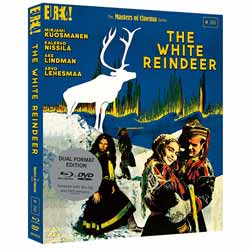|
Click here to return to the main site. Blu-ray Review
Loaded with extras worth the price alone, this gem from Eureka’s Masters of Cinema Series is a limited release of 2000 copies only. If there is further interest be assured Eureka will press more discs for Blu-ray and HD from source elements: a 1080p master from a 4K restoration completed lovingly in 2017 by the National Audiovisual Institute of Finland. What could inspire such interest? It would be viewers of all ages who find lucent delight and awe for one of the most profound examples of black and white imagery in all of cinema. The White Reindeer is categorised as a horror film and indeed it has classic tropes of alter ego, transformation, empowerment through metaphysical and divined destiny but its horror manifestations will only strike today’s fans as quaintly tame. It is safer to market this film for what it is: a folkloric classic beyond the ken of Greco-Roman-Mediterranean familiarity. There is a whisper of Christian myth in one shot where overhead beams cast shadows hinting of a cross, or is it a swastika? The suggestion is for the viewer to mull. The White Reindeer is to its own self true, unashamedly pagan and in that integral commitment, as pure as the driven snow. And snow is its canvas for master cinematographer/director Erik Blomberg (1913 – 1996) and his snow queen heroine Mirjami Kuosmanen (1915 – 1963), his wife and co-writer who is certainly a pantheon member of women in cinema. All of the exteriors are snowscapes. Even the trees are cloaked in ragged carapaces of wind- sculpted iconography. Blomberg shoots everything in wide depth of field. No soft foreground or background. If Kuosmanen’s character Pirita moves forward into a large close up, there is no follow focus we’re aware of. Super depth of field like this is only possible with an abundance of light and the bounce off the white terrain is a case of ‘the cup runneth over’ for Blomberg. It must have taken time and they must have veritably lived outdoors to get these images. If the film has constructed sets, and it does, these are daring in composition and myriad detail within variegated shadow. Matching his aggressive compositional sense in the exteriors, Blomberg is never intimidated indoors. He is a scholar of composition. In the early wedding scene he packs sixteen faces in one frame. In the extras for his remake of The Thing (1982), John Carpenter expresses his unabashed awe for how many faces Howard Hawks crammed in a frame in his 1951 original. Many cinematographers eschew such challenges and prefer the plurality of faces in a single frame to the number one can squeeze into a phone booth. Blomberg is a compositional master. His exteriors remind one of the John Ford rule: the key is where is the horizon? In the Ford masterworks in Monument Valley and Death Valley, this is never more apparent. The choice of the horizon line, or no horizon at all, becomes a nondiscursive statement, a pictorial philosophy of life in the context of cosmos. This same principle is at work in David Lean’s Lawrence of Arabia (1962) where infinite sandscapes surround, embrace and overwhelm pinpoints of humanity in unavoidable inchoate meaning. Huosmanen’s Pirita is gifted with a white reindeer calf by her loving husband (Kalervo Nissilä) to keep her company while he is away on the semi-annual reindeer gathering and herding. The herdsmen reclaim the animals from their natural habitat and bring them back for culling and harvest. (This age old process is depicted in Blomberg’s documentary With the Reindeer (1947) also included in Eureka’s bountiful basket of extras. That award-winning film reminds one of the master of all such films seeking hidden cultures: Robert Flaherty.) Pirita gets desperately lonely and seeks the help of a Nordic shaman, who, though he gives her an herbal antidote, is horrified to discover she is a witch from birth. A wolf witch. Indeed we have seen a prologue wherein Pirita’s pregnant mother (also Kuosmanen) is followed across the barren snow by wolves only for the wolves to hang back because (as we realize later) they sense one of their own in the belly of their intended prey. The shaman directs her to make a sacrifice to the stone god Madder-Ahka. The first animal she sees will be pivotal to her destiny. In sacrificing her beloved Le renne blanc, her animal manifestation is her predestination realized. When the beautiful Pirita is in a killing mood she has not really fangs but attractive canines and sex with her is fatal. We never get to see her bloody victims but only read the damage in the solemn faces of the villagers. Tame, yes, by horror standards but then this is more than a horror movie. It is what great horror movies aspire to and often fall short: a metaphysical disquisition on the mystery of life itself. Kuosmanen is magnificent, charismatic at first sight. She is beautiful but not a wuss with stand-ins for action. We see her laugh luxuriously as she wins a reindeer tow race with her husband to be. We see her wrestle a full grown reindeer to the ground. We trust her goodness of soul without suspicion of entrancement. One of the extras includes Kuosmanen’s colour test and to these eyes she was not as attractive as in black and white, but the artist was also known for her make up professionalism and her colour shots were truly sporty settings without attention to preparation. Brave beauty. The camera is not merely her friend but her abject slave. She is worth discovering. This is the kind of movie that affects dreams, which a great film should do. Shouldn’t it? 10 John Huff Buy this item online
|
|---|

